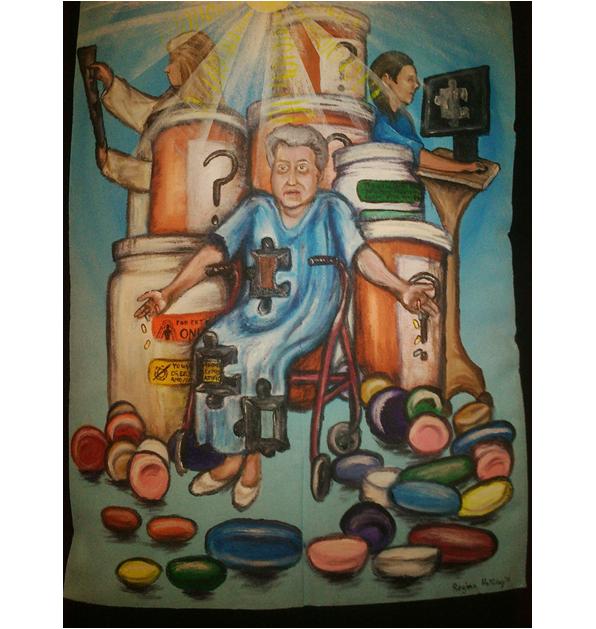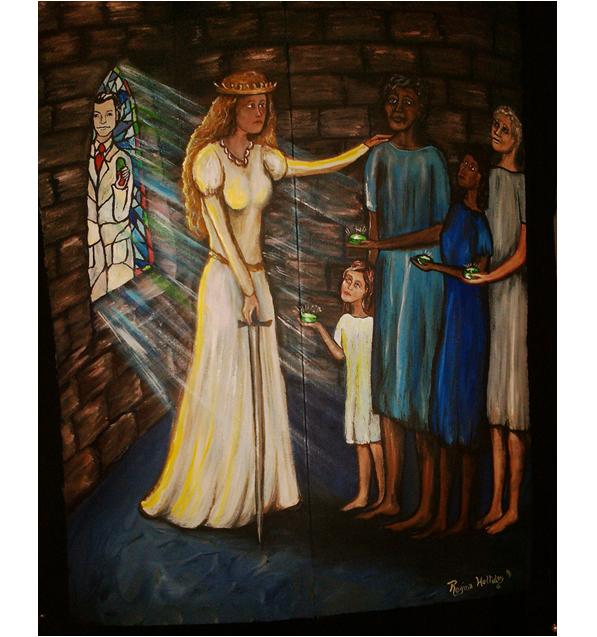Patient perspectives: Regina Holliday

Rebecca Aris interviews Regina Holliday
We interview patients’ rights advocate Regina Holliday on the benefits of transparency in patient medical records and on the general improvement we need to see in the healthcare system and what pharma can do to achieve them.
Regina Holliday knows firsthand how lack of access to patient medical records can impair patients’ care having watched her husband suffer as she struggled to gain access to his records. She now battles to achieve transparency in patient medical records to make sure other patients don’t have the same experience and delivers her message visually through her works of art.
She speaks with us here of how increased access to medical records can improve the patient experience and overall healthcare and how she thinks pharma could help in improving healthcare.
Interview Summary
RA: Hi Regina, thanks for joining me today. Can you start by giving me a bit of background and explain how you came to be a patients’ rights arts advocate?
RH: All my life I have enjoyed drawing and painting. I was learning disabled when I was small, I couldn’t read, so I would try to do visual storytelling to communicate. In college I met and married this wonderful guy named Frederick Allen Holliday, we actually met in a scenic painting course.
In the fall of 2008 my husband started having fatigue and later he started having extreme pain symptoms. He just was given pain medications, and then laxatives, and then muscle relaxants, and we had no idea what was wrong with him.
After weeks of not knowing what was wrong we demanded an MRI. My husband was told that he had tumours and growths throughout his abdomen and a three centimetre tumour in his kidney.
By the time I got to the hospital my husband’s doctor had left town for a medical conference and would be gone for the next four days. I spent days begging for information about my husband’s care, and this continued for several weeks with very little access to information. I was told it would be 73 cents a page and a 21-day wait to see the medical record while we were hospitalised.
We were transported to another facility, and were sent with an incomplete and out of date medical record and transfer summary, and that meant when we got to the new facility they were unable to provide care because they had no idea of his medical standing.
 ,
"...the same exact problems are happening nationwide in hospital after hospital and nobody is aware of it."
 ,
The very next day the new doctor sent us back to the old hospital to get the entire medical record. I laughed, because I’d tried this. The new doctor said, “Well they will this time because we’re sending you as a courier.” I went back and they printed it out in an hour and a half, and gave it to me. I read it, and I was furious because it was full of actionable data, it was full of information that would have impacted his care directly, emotionally, and physically.
I had all these years of art and visualisation behind me in my life, and when I heard this I thought I have to paint about this. I have to create this visual message about transparency of care, and make sure other people don’t have to suffer like my husband did.
Figure 1: ‘Drugs writ large’ picture from Regina Holliday’s documentary team of Tessa Moran and Ben Crosbie – used with Regina’s permission
So this event tipped me into a different role on to a different life path, which was trying to explain the complex world of medication, hospitalisation, end of life, health information technology, using a visual image.
RA: What do you think needs to be done in order to achieve clarity and transparency in medical records? What do you think needs to change?
RH: Patients and caregivers have to have real time access to their own electronic medical records. Access within 24 hours is something we’re working towards right now, but our goal is to have real time access.
If you open this up and let people actually see their own records you achieve this amazing crowd source group of people. When you crowd source a problem all of a sudden you have way more brilliant minds working on it and all of this brainpower comes to the fore and we start fixing things and seeing national aggregate patterns. We start seeing where things are not working. Right now you just have a whole bunch of silos, people aren’t talking to each other. The same exact problems are happening nationwide in hospital after hospital and nobody is aware of it.
 ,
"Patients and care givers have to have real time access to their own electronic medical records."
RA: What do you think is stopping achieving clarity and transparency, what do you think are the challenges?
RH: The biggest challenge is fear. There is fear of legislative harm, so some individuals feel that if we were to be open with medical records, people would sue if there are errors within them. The current way to deal with problems within the world of medicine is usually a litigation model where the only solution is suing and we’ve got to change that. We have to go to a system that’s more like aviation safety where when we find problems we start rectifying them and rectifying them on a national scale instead of blaming the person we need to fix the system.
The other issue is ROI. There’s an attitude of what’s the incentive to fix things, because right now a lot of money is being made within medicine. We have to change our model to being a wellness model instead of sickness model. The incentives now are set up in such a way to have additional and sometimes unnecessary testing. If a person is infected actually you get paid more because they’re staying in the hospital longer. The incentives need to change direction.
We need to move our incentives towards the patient having a good life, being free of pain, having a good quality of life, and being cured, if possible.
Figure 2: ‘Subjects as Equals’ picture from Regina Holliday’s documentary team of Tessa Moran and Ben Crosbie – used with Regina’s permission
RA: How do you think the pharma industry can help to achieve this?
RH: I would really appreciate it if the pharma industry would do everything they could in their power to help patients see their medical administration record and the medical reconciliation report. The medical administration report shows, for a hospitalised patient, the drugs you’re on, what quantities and what time you’re supposed to take them. The medical reconciliation report dictates what you actually took, how often you took it, and the warnings about the drugs. Hospitals are under staffed, they’re very busy places, nurses come in with a cup in their hand with pills and water for the patient to take. They often don’t explain what the medication is.
Patients can be rushed through discharge and they can be very unsure as to what it is they’re taking and when they’re supposed to take it. This could all be fixed to a great extent by really utilising patient education while still in the hospital setting.
In addition, patients can go into a hospital already taking a certain set of meds. They can then be taken off those, and they’re not reinstated appropriately. So we need to have improved communication so that patients are part of their medication and understand why they are being taken off certain medications so that the entire drug regimen doesn’t slip through the cracks leading to patient harm within a hospital setting.
 ,
"The current way to deal with problems within the world of medicine is usually a litigation model where the only solution is suing and we’ve got to change that."
 ,
RA: How would the patient experience be different if we achieved transparency with patient medical records?
RH: In business people speak of employees taking ownership, which means they own their experience, they are part of the team and they begin to believe that they truly effect change. When you give people data access, you let them be part of their experience and be able to input and comment on it. You then change the entire paradigm shift and you have a different way of thinking about the problem.
When you give people these opportunities they take an active part in finding a solution then they tend to get better quicker, have improved results and they tend to be happier.
We’ve taught patients for a very long time that it’s a submissive role within medicine. We’ve put the entire onus on the medical professional within the doctor-patient role-play and the patient has nothing to do. We have to change our play, and change the way we see things, because this is an equal partnership.
RA: Finally what would your key message be to the pharmaceutical industry, how can it better meet patient needs?
RH: I would highly consider recommending that they open clinical trial study information so that patients feel part of the process and it would make pharma appear more open and transparent.
In addition, once studies are finished there didn’t used to be any transparency as to the results. People want to know the results, they feel they were part of a team that did something amazing and whether the results are positive or negative, they want to know.
My other message would be to support legislative change. If you’re a pharmaceutical company you have a voice within public comments for a federal register and you have the ability to say we think it’s important that patients see their own information. It will help to make sure that patients are taking their drugs on a regimen that is scientifically preferred.
RA: Regina it’s been a real pleasure speaking with you, and I hope your work continues to help other patients.
RH: I believe it will.
About the interviewee:
Regina Holliday is a patients’ rights advocate and medical muralist in Washington, DC. She is using social media and public walls to inform citizens of the need for real time access to patient data, transparency in terminology and interoperability of systems. After treatment at five different facilities in a less than three month period, Regina's husband Fred Holliday died of kidney cancer on June 17th. As a caregiver on-site for her husband, she witnessed firsthand how the current system is failing caregivers and patients. She saw the situation as a call to action and began a series of murals chronicling the problems accessing data in the current medical system. National and international media have covered the progress of her mural "73 Cents". This mural depicts her husband dying in darkness surrounded by inaccessible tools of technology in a closed data loop. The title "73 Cents" refers to the cost per page for your medical record in the state of Maryland.
Her images can be seen on her Flickr stream.
How can we achieve transparency in patient’s medical records?













